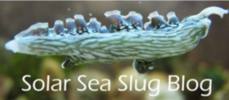

Observations on Algae
Happy Holidays to all of you fans of slugs!
Although the site and the project are devoted to adorable molluscs, we would be nowhere without algae. These days, I spend more time and resources trying to acquire, grow, and identify algae than I do attending to Elysia. It should not be a surprise, given the outsize role of algae in the biology of the slugs, but, until this project was underway, I had never given a lot of thought to the care and diversity of algae. Subsequent posts will describe some of the progress in algae care, but today we’ll focus on some systematics and molecular biology.
The plant in the photo above has been nagging at me for well over a year. I can’t remember exactly how it came up, but KP Aquatics mentioned that they had a species of algae they called “spongy sea pansy,” which was like Udotea, but larger and squishier. They were quite a bit taller than Udotea, grew in clumps, and were indeed quite spongy. Their biology is somewhat different from other algae in the order, in that the thallus (the body of the alga) dies back periodically, and a new one grows from the rhizoid (the rootlike part). In my experience, species like Udotea or Penicillus send out runners that produce new thalli, and the old ones just die off.
I have been referring to them as Avrainvillea, because they fit the description reasonably well, but had never done the hard work of verifying that it was not a similarly squishy genus, such as Rhipilia or Cladocephalus.
A real phycologist (algae specialist) would have probably started with a good microscope and species key. I took the molecular route, since I was already using PCR to amplify DNA from the rbcL gene in a few other species, and sending it off for sequencing.
Because I was testing new PCR machines, I had set up three independent reactions, and the results were the same. The screenshot below shows the results of a BLAST search for one of the sequences through the NCBI database, with the closest match at the top. The second best, with 98% of the nucleotides being identical, is Avrainvillea nigricans. The best match (99%) is to an “uncultured Ulvophyceae” clone from a study by Christa, Gould, Wagele, and their collaborators. If I read the entry correctly, the sequence is from kleptoplasts extracted from Costasiella, a Caribbean slug that feeds on…did you guess…Avrainvillea. To provide a little context, Cladocephalus and Rhipilia, the genera that were possible candidates based on appearance, were only 93% and 82% identical, respectively.
That is a pretty clear-cut result. It looks like Avrainvillea, it is squishy like Avrainvillea, and its DNA is essentially an exact match for Avrainvillea nigricans. It is Avrainvillea.
As you’ll see in the next post, the results aren’t always so easy to interpret.




Hey, I’m a student, majoring in biology and I’m trying to identity this plant from Philipines but I could not find any image on the net that is similar to this plant I believe ba that it belongs to Udoteaceae
Could you please help me in Identifying?
If you post or send a photo, I will try to help out.